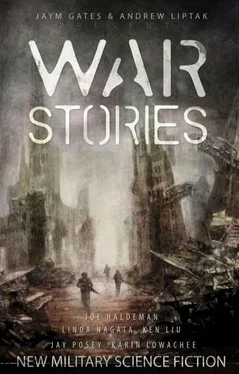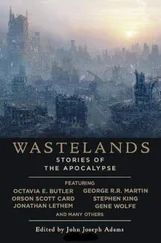When Kay tried to thank Jassalan for saving her, she only shrugged and said, “Payl likes you, she ran home to get us as soon as she found out what was going to happen. I couldn’t just let them kill you.”
Liss had pointed out wryly that she’d killed Bolus, and Jassalan sighed. “It’s never simple,” she said at last, her eyes heavy with something that might have been regret. The matter dropped.
“So, you’re set,” said Liss. “You can call off–planet. It’s all connected back up. You can call for rescue, get off this dirtball.”
“Though you don’t have to,” said Payl. “If you don’t want.”
Kay thought of the sequence that would open the channel. Payl’s smile was tight. Jassalan looked away.
Kay pondered that sequence. She could go home. She could see the Army again, have a mission again.
She glanced at Payl, then at Jassalan. The Army hadn’t come back for her.
But these people had.
“It’s… not working,” Kay lied. “I can’t get through. Maybe it’s not strong enough.”
“Well,” said Jassalan, not buying that for a second. “You’ll just have to stay here until we fix it better.”
There was a soft rustling sound on the roof, and Kay glanced outside. Big raindrops had begun to fall from the sky.
“Rain!” shouted Payl, running past. “Rain!”
Liss scrambled up and followed Payl outside.
Jassalan and Kay were left alone.
“I accessed the file,” said Kay softly.
Jassalan held up her hand. “Don’t tell me,” she said. “I don’t want to know.”
“But—”
“No,” said Jassalan, and her smile was genuine and warm. “You’re welcome here no matter who you were. All right? Now… go help with the collectors, Kay. It’s raining.”
Kay ran outside to help Payl and Liss deploy the collectors. Kay felt each drop rain on the skin of her face and the metal of her arms.
“You brought the rain! You brought the rain!” whooped Payl, face lit up with joy.
And, for a fleeting moment, Kay was utterly certain that she had.
Contractual Obligation
James L. Cambias
BLUE SIX AND THE REST of the grunts power up to battle–ready at T–minus fourteen hours. They don’t need much lead time before action; even if the squad’s fully shut down it takes them less than ten minutes to get operational. No, the extra time isn’t for the grunts, it’s for the officer.
Captain Yamada’s in the fridge. He’s been in there since the space freighter left the last neutral station at L5, a hundred days ago. It takes three hours just to raise his body temperature to normal, another couple of hours for muscle stimulation. Releasing some fluids and taking in others. Cleaning off the outer layer. It’s not until T–minus seven hours that Yamada steps through the pressure membrane into the embrace of his armor.
In battle dress, the officer looks almost like one of the grunts. They’re a mixed bunch anyway. Blue One’s a superheavy class, two metric tons of armor and power plant wrapped around a hypervelocity rail gun and a thousand–round magazine. Blue Two and Three are standard heavies, armed with autofire grenade launchers and weighing in at just over three hundred kilos each. Four and Five are low–profile scuttlers, only fifty kilos, with caseless submachine guns and extra limbs tipped with multitools. Blue Six is a point–defense specialist, with twin lasers and an elaborate sensor suite—which also makes it the electronic–warfare unit and primary communications node by default. All the grunts share a single distributed intelligence, but at any given time most of it’s running on processors inside Blue Six.
When he’s functional and suited up, Yamada runs through the list of mission parameters one last time. He toggles the rules of engagement settings from “WEAPONS FREE” to “HUMAN SAFE.”
That gets the squad’s attention. “That isn’t in the contract, Captain.”
“Which means I’m free to decide. I want to make this as bloodless as possible.”
“Yes, Captain.” The squad can do non–lethal. It means they can still shoot other robots, and that’s the important thing. If you have to rely on human troops, you’ve lost the battle.
Six hours out, the freighter’s eyes can see the target: Anfa Habitat. From the freighter’s angle it looks like a dark flower against the Sun’s disk. Anfa Habitat is a giant sphere a kilometer across, with six big solar panels stretching out from the equator. The docking hub’s down at the “dark pole” of the sphere, with four docking tubes sticking out at right angles. Beyond the docking hub, a long boom stretches a hundred meters or so into the sphere’s shadow, with big radiator fins running down each side and the backup power reactor at the far end. Anfa orbits the Sun sixty degrees ahead of Venus, so the radiators are glowing bright infrared as they dump the habitat’s excess heat.
Anfa control takes over the freighter soon after—or at least Yamada allows them to think they have. The controllers inside Anfa do a good job. There’s a hard braking burn to shift the freighter from its transfer orbit to match vectors with the habitat, and then some short burns and rotations to line up with the docking tube. There’s no voice chatter from the controllers; according to the manifest, this is a load of humanitarian supplies.
Docking clamps thump together right at T–minus zero, and now it’s time to move. Yamada pops the external cargo hatch—not the one connected to the docking tube—and the whole squad goes out onto the hull, moving fast. Blue One takes up a position behind the hatch to provide covering fire; Six joins it to act as spotter. The other four surge forward along the outside of the docking tube, followed by Yamada.
Having the officer out on the front line is part of the plan, but the squad thinks it’s a bad idea. A battle’s no place for humans. The captain could keep his fragile biological butt parked back in the relative safety of the freighter and stay in the loop by telepresence. But this job requires some diplomacy, and faceless killing machines are still getting the hang of that.
Blue Six scans the battlespace and picks out possible targets. The biggest danger is Anfa’s main defense lasers, located at the tips of three of the solar panels. The lasers can vaporize one of the grunts with a single shot, which is why the squad is keeping the metal docking tube between themselves and the habitat. But Anfa might have free–flying drones with laser mirrors, so Six watches the sky for anything moving.
There! A small shape moving against the stars. It’s dark, which puts it in the shadow of the habitat. Close, then. The squad’s multiple eyes triangulate, and Blue One takes aim.
Yamada’s orders are clear: no combat of any kind until he gives the word. Don’t let the enemy know there’s a battle going on until it’s won. So Blue Six keeps watching the drone, pinging alerts at the officer to make sure he sees it too.
More targets! Four maintenance drones come scuttling along the docking tube from the hub.
“Engage engage engage!” Yamada orders. “Damn.”
Before the captain has time to inhale again after speaking, Blue One hits the mirror drone with a chunk of depleted uranium going three kilometers per second, and Blue Two through Five each blow a maintenance bot to twinkling fragments. Six scans every surface in sight, looking for cameras and blinding them.
Now it’s time to get fast. While the debris clouds are still expanding, the squad sprints up the tube to the docking hub. The officer must be juicing his sluggish biological nervous system with something, because he’s only a second behind.
The maintenance drones came out of a hatch at the docking hub, where the four tubes meet. It’s a typical membrane, but an armored door is swinging shut as they reach it. Blue One grabs the edge of the aluminum door, and for three long seconds there’s a contest between the big bot and the motor in the door hinge, but sheer power wins out and the hatch jerks open again.
Читать дальше












